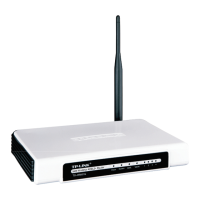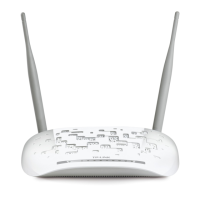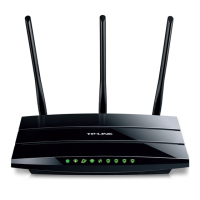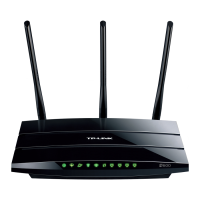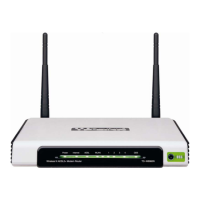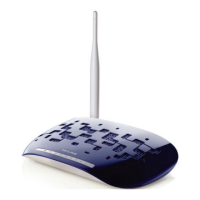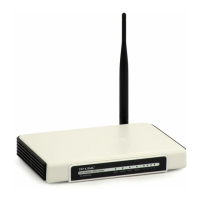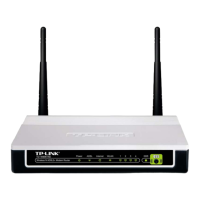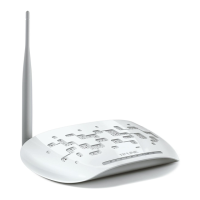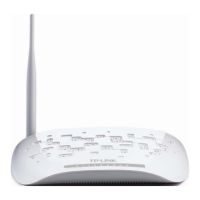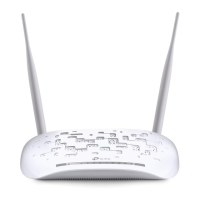FAQ (Frequently Asked Questions)
Q1. What can I do if the login page does not appear?
A1. Make sure the computer is connected to the modem router properly.
A2. If the computer is set to a static or xed IP address, change the computer’s settings to
obtain an IP address automatically from the modem router.
A3. Verify http://tplinkmodem.net or 192.168.1.1 is correctly entered in the web browser
and press Enter.
A4. Use another web browser and try again.
A5. Reboot your modem router and try again.
A6. Disable and enable the active network adapter.
Q2. What can I do if I cannot access the internet?
A1. Make sure the telephone and Ethernet cables are plugged in correctly.
A2. Try to log in to the web management page of the modem router using the default
address at http://tplinkmodem.net or 192.168.1.1. If you can, try the following answers.
If you cannot, change your computer’s settings to obtain an IP address automatically
from the modem router.
A3. Consult your ISP and make sure all the VPI/VCI, Connection Type, account username
and password are correct. If they are not, please replace them with the correct settings
and try again.
A4. Restore the modem router to its factory default settings and recongure the modem
router by following the instructions in this Quick Installation Guide.
A5. Please contact our Technical Support if the problem persists.
Q4. What can I do if I forget my password?
Web management page password:
Refer to FAQ > Q3 to reset the modem router, and then use admin (all lowercase) for
both username and password to log in.
Wireless network password:
A1. The default Wireless Password/PIN is printed on the product label of the modem router.
A2. If the default wireless password has been changed, log in to the modem router's web
management page and go to Interface Setup > Wireless to retrieve or reset your
password.
Configuring the Modem Router
2. Conguring the modem router via a web browser.
Enter http://tplinkmodem.net or 192.168.1.1 in the address bar of a web
browser. Use admin for both username and password, and then click Log in.
A
Note: If the login window does not appear, please refer to FAQ > Q1.
A Quick Start window will pop up. Click NEXT, and select your Time Zone,
then click NEXT.
B
Click SAVE to complete the conguration.
E
Quick Start - Wlan
EXIT
BACK
NEXT
TP-LINK_XXXXXXSSID :
Authentication Type: WPA2-PSK
Encryption : AES
Pre-Shared Key :
XXXXXXXX
Broadcast SSID : No
Yes
Access Point : Activated Deactivated
Verify or change the Wlan settings (wireless network settings) and click NEXT
to continue.
D
Note: You may personalize your SSID (wireless network name) and key. Once done, you will have to
reconnect to your wireless network using the new SSID and key.
Note:
All the internet settings in the figure below are used for demonstration only. If you are unsure of the
internet settings, please contact your ISP.
Quick Start - Internet Settings
EXIT
BACK
NEXT
Other
Country:
ISP: Other
ISP Connection Type: PPPoE/PPPoA
Connection Type: PPPoE LLC
VPI:
8 (0~255)
VCI:
35
(32~65535)
XXXXXXXXXXX
Username:
********
Password:
Complete the Internet Settings with the information provided by your ISP
and click NEXT. Here we use PPPoE/PPPoA for demonstration.
C
Q5. What can I do if the ADSL LED does not turn solid on?
A1. Check your cables and make sure they are all plugged in correctly, including the
telephone lines and power adapter.
A2. Manually change your DSL settings. Log in to the modem router’s web management
page. Go to Advanced Setup > ADSL, change the ADSL Mode to G.DMT, and click
SAVE. If this cannot work, try to change the ADSL Mode to ADSL2 and click SAVE.
A3. Restore your modem router to its factory default settings.
A4. Remove the ADSL splitter, directly connect the modem router to the phone jack and
then recongure the modem router by following the instructions in this Quick
Installation Guide.
A5. Contact your internet service provider to verify if the ADSL line is in good status.
A6. If you have tried all the suggestions above and the problem persists, contact our
Technical Support.
Wireless
1. Connecting your computer to the modem router (Wired or
Wireless).
Ethernet cable
Connect the computer to the LAN1, LAN2, LAN3 or LAN4 port on your
modem router with an Ethernet cable. And the LAN LED lights up.
a Find the SSID (network name) and
Wireless Password printed on the
product label at the bottom of the
modem router.
b Click the network icon of your computer or go to Wi-Fi Setting of your
smart device, then select the SSID to join the network.
7106507148 REV4.0.1
©2017 TP-Link
Wired
Smart Device
Wi-Fi
Wi-Fi
TP-LINK_XXXXXX
CHOOSE A NETWORK...
Other...
< Settings
Computer
Connect automatically
Connect
TP-LINK_XXXXXX
admin
admin
Log in
Username:
Password:
http://tplinkmodem.net
Quick Start - Time Zone
(GMT) Greenwich Mean Time : Dublin, Edinburgh, London, Lisbon
EXIT
BACK
NEXT
Q3. How do I restore the modem router to its factory default settings?
A1. With the modem router powered on, press and
hold down the WPS/RESET button on the rear
panel of the modem router for at least 10
seconds until the Wireless LED turns o
momentarily, then release the button.
A2. Log in to the web management page of the modem router, and go to Maintenance >
SysRestart, select Factory Default Settings and click RESTART, then wait until the
reset process is complete.
WPS/RESET Button
Press & Hold for 10 seconds
POWER ON/OFF
WiFi
WPS/
RESET
LAN4
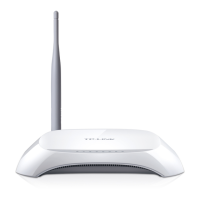
